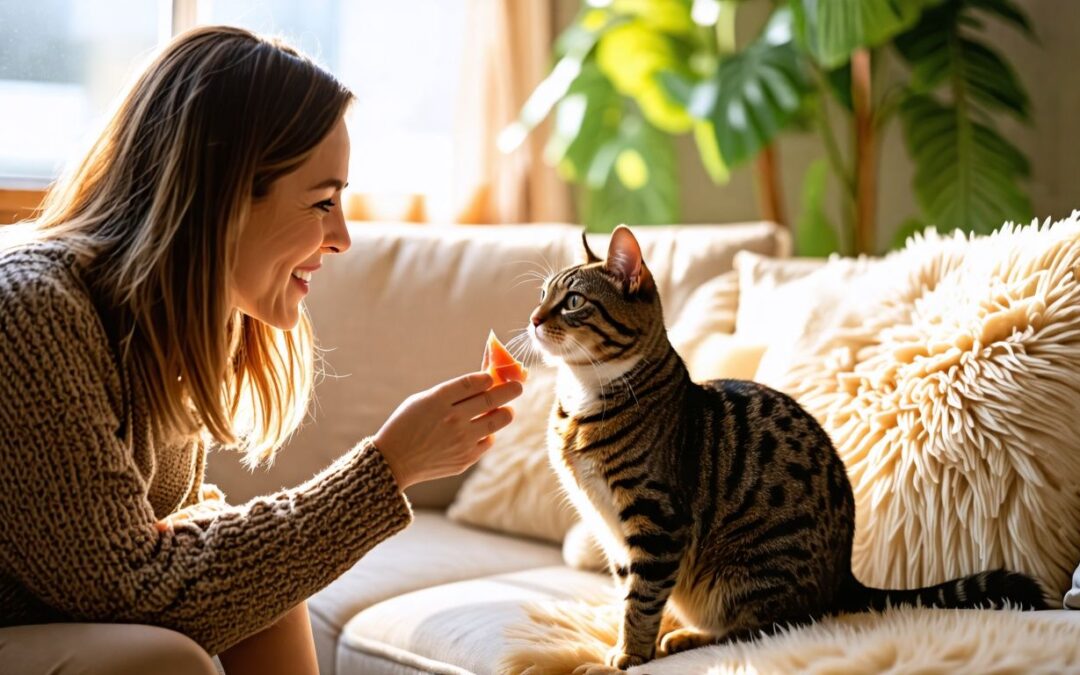Are you wondering if prosciutto is a safe treat for your furry friend? Interestingly, while not the healthiest option, prosciutto can be given to cats in moderation. This article will explore why cured meats like prosciutto may not always align with optimal kitty nutrition but can still fit into their diet occasionally.
Keep reading to discover how to safely share this delicacy with your cat.
Key Takeaways
- Prosciutto contains a lot of sodium and fat, which can lead to health issues for cats like dehydration, hypertension, obesity, and pancreatitis if they eat it too often.
- While prosciutto isn’t toxic to cats, it’s important to give them only small amounts as an occasional treat due to its high salt content and the risk of foodborne pathogens like Salmonella or Listeria.
- Healthy cat treats are better options than cured meats such as prosciutto because they meet dietary needs without added risks.
- If choosing to feed your cat prosciutto, cut it into tiny pieces and limit the serving size; also ensure it’s free from additional seasonings or spices that could be harmful.
- You can make snack time interesting by creating creative treats with prosciutto in moderation alongside healthier ingredients.
Can Cats Eat Prosciutto?
Cats often want a taste of human food, but prosciutto might not be the best option. It contains too much sodium and fat, which can harm your cat’s health if eaten frequently.
Reasons why cats shouldn’t have cured meats
Cured meats like prosciutto pose several concerns for cats. High sodium content can lead to health issues such as dehydration and hypertension. Cats are also prone to obesity if they consume too many treats that are high in fat, making moderation crucial.
Regular consumption of cured meats may increase the risk of pancreatitis, which is a painful condition affecting their digestive system.
Feeding cats prosciutto or similar deli meats should be done with caution due to potential stomach upset and vomiting. There are no toxic substances in prosciutto itself, but the risks outweigh the benefits when considering a balanced feline diet.
Many healthier options exist for cat treats that do not carry the same health risks associated with processed cured meats.
The importance of a balanced feline diet
A balanced feline diet is crucial for maintaining a cat’s health and well-being. Cats require specific nutrients, including proteins, vitamins, and minerals, to thrive. Feeding your cat a diet rich in high-quality protein is essential since they are obligate carnivores.
While prosciutto contains protein and some vitamins, it also has high sodium and fat content that can lead to health issues like obesity or pancreatitis if consumed regularly.
Providing human food as treats can be tempting but consider the long-term impacts on cat health concerns. Choosing veterinarian-approved cat foods ensures that the dietary needs of felines are met without introducing harmful human foods for cats into their diets.
Healthy options promote better overall health while limiting risks associated with poor nutrition choices like prosciutto or other cured meats.
Potential Benefits & Risks of Feeding Cats Prosciutto
Feeding prosciutto to cats can lead to some benefits but poses significant risks. High sodium and fat content may contribute to health issues like obesity or pancreatitis, while contamination could also be a concern.
Risks of obesity and pancreatitis
Feeding prosciutto to cats carries risks of obesity and pancreatitis. Prosciutto is high in fat, which can contribute to weight gain if given too frequently. Cats are prone to obesity, leading to various health issues such as diabetes and joint problems.
Regular consumption of fatty treats like prosciutto may also trigger pancreatitis, a painful condition resulting from inflammation of the pancreas.
Limit feeding prosciutto to once every few weeks or once a month. The sodium content poses additional concerns for feline health. While there’s nothing toxic in prosciutto for cats, moderation is crucial to avoid these potential complications associated with their diet.
Prioritizing healthier cat snacks over cured meats benefits overall well-being while satisfying their protein needs.
The impact of prosciutto’s sodium, fat, and protein content
Sodium, fat, and protein content in prosciutto can significantly impact feline health. Prosciutto contains a high sodium level, which is salty for cats. Excessive salt intake may lead to various health issues over time.
Cats require only small amounts of sodium for proper bodily functions. The fat content also raises concerns; while it provides energy, too much can contribute to obesity and pancreatitis in cats.
Protein is essential for felines but should come from balanced sources like veterinarian-approved cat foods. Although prosciutto offers some protein benefits, it lacks the complete nutrient profile that cats need daily.
Giving them this cured meat on occasion poses risks due to its rich composition. Consequently, moderation is crucial when considering treats like prosciutto for your feline friend.
Contamination risks
Feeding prosciutto to cats carries potential contamination risks. Processed meats like prosciutto can harbor harmful bacteria such as Salmonella and Listeria. These pathogens pose a risk of foodborne illness, which may lead to stomach upset and vomiting in cats.
Although prosciutto is not toxic for felines, ensuring its safe preparation is crucial. Cured meats often involve additives that can further compromise safety if hygiene standards are not met.
Cats benefit from a balanced diet rich in protein, vitamins, and minerals rather than relying on cured meats as treats. Safe cat treats should prioritize their overall health needs while minimizing risks associated with foods like prosciutto.
If you choose to offer your cat a nibble of this delicacy, limit the frequency to once every few weeks or even monthly to mitigate any adverse effects related to contamination or excess sodium intake.
How to Safely Feed Prosciutto to Cats
To safely feed prosciutto to cats, use only small amounts as an occasional treat. Prepare it by cutting it into tiny pieces and removing any excess fat before offering it to your cat.
Suitable quantities
Feeding prosciutto to cats should be done with care. Limit the quantity to a small nibble or two, as this cured meat can be rich in sodium and fat. It is not harmful if given in moderation, but excessive consumption may lead to stomach upset and vomiting.
Offering prosciutto once every few weeks or even once a month is advisable for a safe treat without jeopardizing your cat’s health. While there are healthier snack options available, an occasional taste of prosciutto will satisfy some felines without causing significant harm.
Safe preparation methods
Prosciutto can be a tasty treat for cats, but it’s crucial to prepare it safely. Focus on moderation and hygiene to keep your feline friends healthy.
- Choose high-quality prosciutto: Look for brands that use natural ingredients without artificial preservatives. Quality matters, as this reduces the risk of contamination and unhealthy additives.
- Cut into small pieces: Slice the prosciutto into tiny, manageable bites. This prevents choking and helps cats enjoy the flavor without consuming too much fat or sodium at once.
- Limit portion size: Just a small nibble is enough for an occasional treat. Too much prosciutto can lead to stomach upset or vomiting in some cats due to its rich content.
- Always check for salt content: Prosciutto is salty, which isn’t ideal for cats’ diets. Make sure to limit treats to once every few weeks or a month to avoid health issues related to excessive sodium intake.
- Avoid added seasonings: Ensure the prosciutto has no additional seasonings or spices that could harm your cat’s digestive system. These ingredients may upset their stomachs or pose other health risks.
- Monitor your cat after serving: Keep an eye on your cat after giving them a little prosciutto. Being watchful allows you to catch any adverse reactions early on, such as vomiting or discomfort.
- Store correctly: Always refrigerate leftover prosciutto and seal it tightly in an airtight container. This helps prevent spoilage and ensures the meat remains safe for future use as a treat.
- Create DIY treats: Use small pieces of prosciutto mixed with healthier options like cooked chicken or fish to make nutritious snacks at home. Combining these ingredients can offer taste while maintaining balanced nutrition for your cat.
These preparation methods help keep your cat’s overall diet in check while allowing them a flavorful snack from time to time!
Creative prosciutto treats for cats
Cats can enjoy prosciutto as an occasional treat, but it should be offered carefully. Here are some creative ways to incorporate this tasty meat into your cat’s diet while keeping their health in mind.
- Prosciutto-Wrapped Cat Treats: Take small pieces of chicken or fish and wrap them in thin slices of prosciutto. Bake them at a low temperature for a few minutes. This adds flavor and makes the treat more appealing to your feline friend.
- Prosciutto Crumble Topping: Cook some prosciutto until it’s crispy, then crumble it over your cat’s regular food. This gives their meal a special twist without overwhelming them with salt.
- Homemade Prosciutto Cat Biscuits: Mix prosciutto with pumpkin puree and oat flour to create a dough. Cut out small shapes and bake until firm. These biscuits provide protein while using healthier ingredients.
- Prosciutto Frosting for Toys: Create a light paste using blended prosciutto and water, then smear it on your cat’s favorite toys or balls. This encourages playtime while introducing a unique taste.
- Frozen Prosciutto Treats: Chop up small pieces of prosciutto and mix them into ice cube trays filled with water or chicken broth. Freeze these cubes for a cool treat on hot days that also helps hydrate your cat.
- Prosciutto Stuffed Kongs: Fill a Kong toy with small chunks of prosciutto combined with other kitty-friendly ingredients like plain yogurt or mashed sweet potatoes for an interactive snack that keeps them busy.
- Catnip & Prosciutto Mix: Blend dried catnip with finely chopped prosciutto and sprinkle it onto their scratching post or bed to create an inviting scent that cats love, enhancing their playtime experience.
These creative ideas allow you to offer prosciutto safely while thinking about their overall health needs, keeping servings moderate since it’s richer than most treats they typically eat.
Conclusion
Feeding prosciutto to your cat can be a fun treat, but moderation is key. While it’s rich in protein and other nutrients, the high sodium and fat content make it less than ideal for regular meals.
Occasional bites are fine, but there are healthier snack options available too. Always consider your cat’s overall dietary needs when sharing human food. Keep their health as a priority!
FAQs
1. Can cats eat prosciutto and other cured meats like ham, bacon, or salami?
While cats can consume protein from meat, it’s important to note that not all human foods are safe for them. Prosciutto and other cured meats may pose health concerns due to their high salt content.
2. What could happen if my cat eats too much prosciutto or similar deli meats?
Feeding your cat excessive amounts of prosciutto or other deli meats can lead to feline pancreatitis – a serious health issue in cats caused by an unhealthy diet.
3. Are there any veterinarian-approved cat foods I should give my pet instead of prosciutto?
Yes, there are many veterinarian-approved cat foods available that provide the necessary nutrients for your pet’s health without the risks associated with human food like prosciutto or sausage.
4. Can I offer pork as a healthy snack for my cat?
While pork is a source of protein, it’s best served cooked and in moderation as part of a balanced diet to ensure your cat stays healthy.
5. Is it okay if my cat eats small bites of cured meat once in a while?
Small portions might be harmless occasionally but regular consumption can lead to long-term health issues in cats due to high sodium levels found in these types of food.






